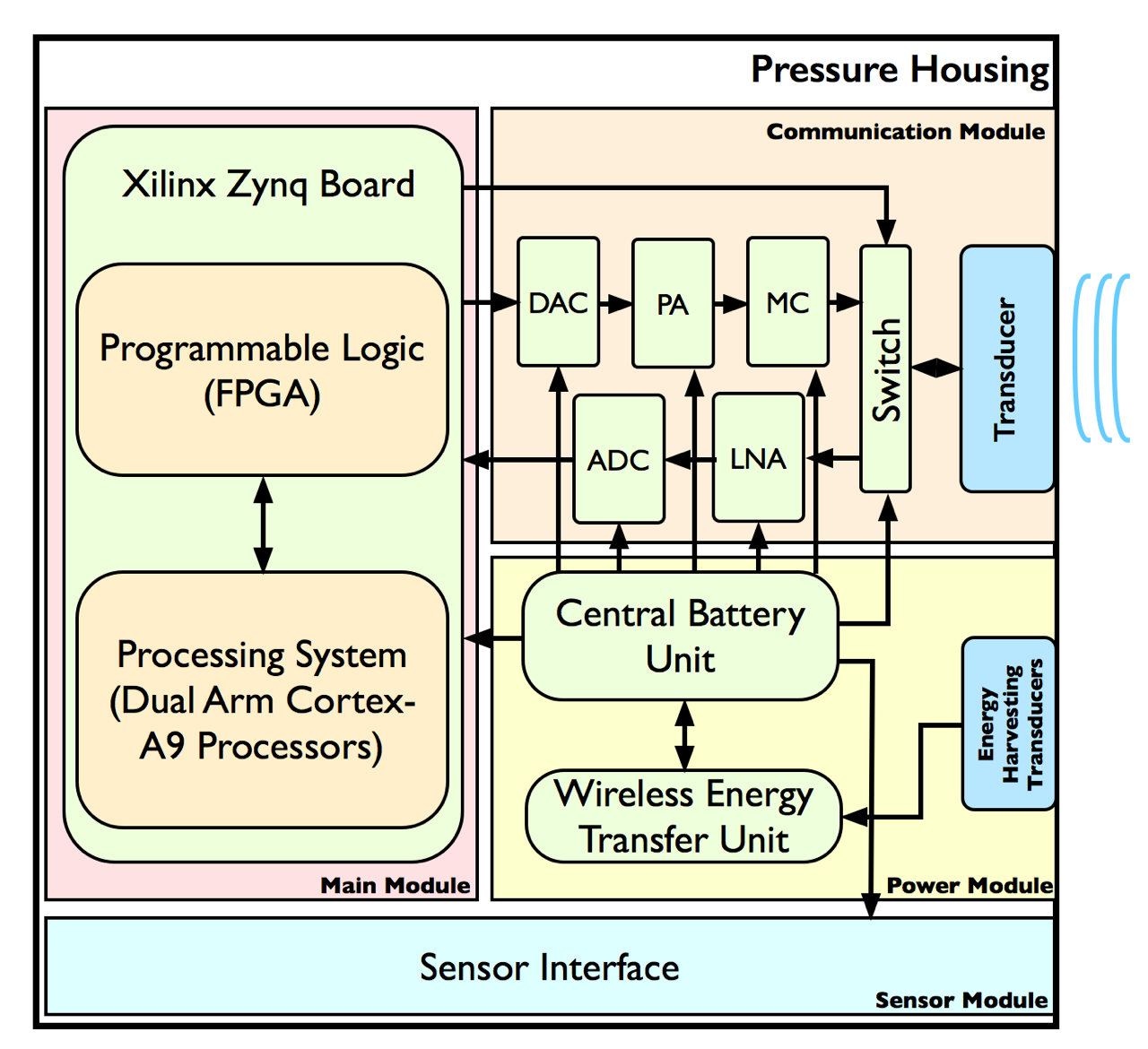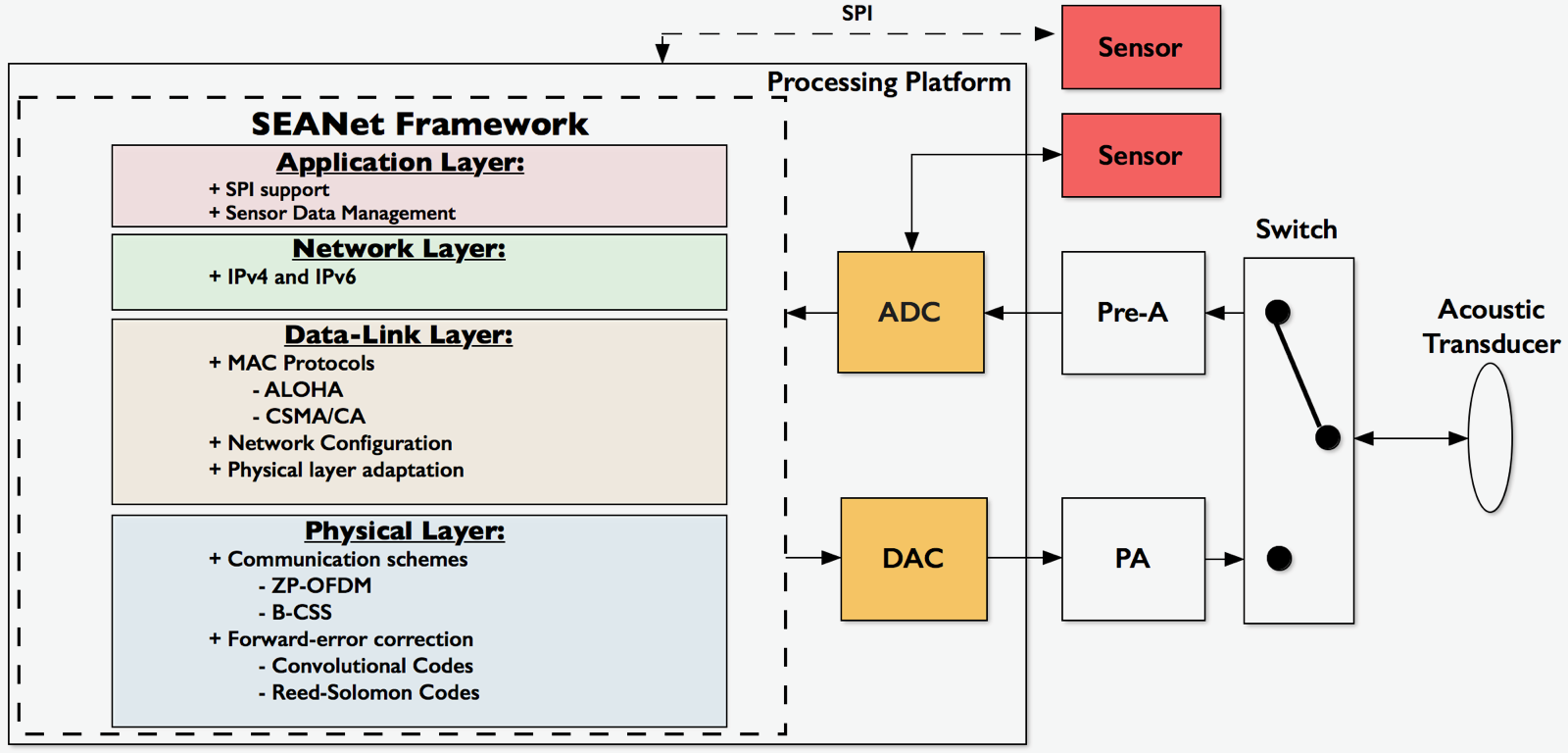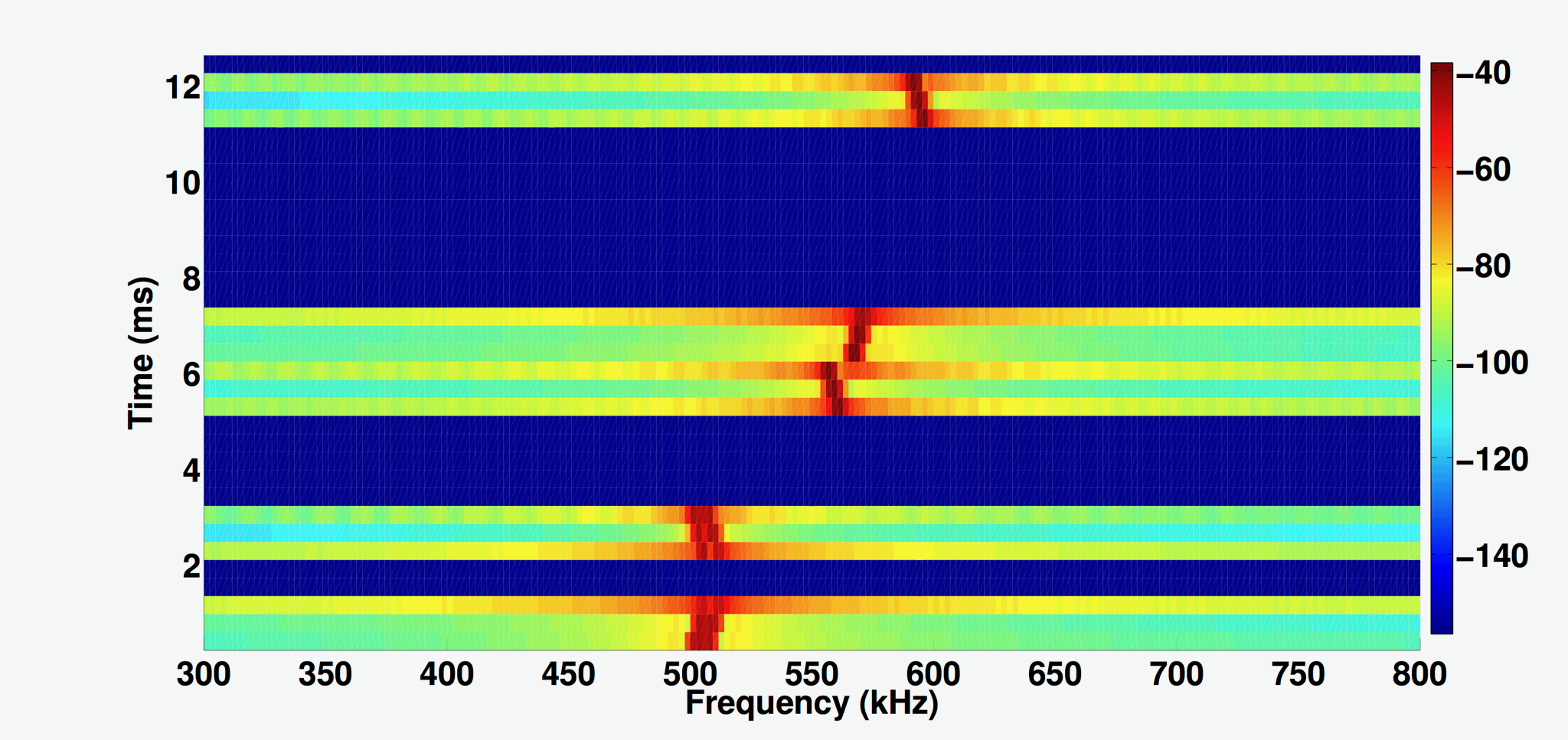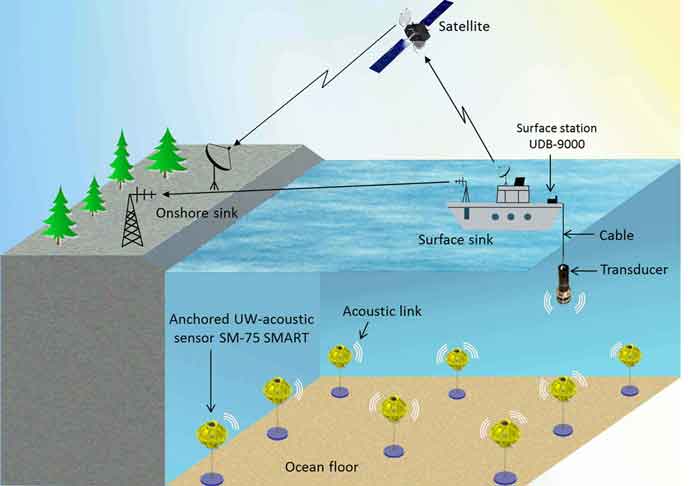The Underwater Internet
 |
Current underwater acoustic wireless communication platforms are still based on inflexible hardware that can support mostly point-to-point, low-data-rate, and delay-tolerant applications. Regrettably, these devices do not provide the data rates or the flexibility required to enable future underwater networking applications and systems that envision i) real-time video streaming, ii) capability to control and adapt in real time communication parameters (including modulation, frequency channel, coding scheme, channel access probability) based on channel condition/state and application needs, and iii) capability to develop and test advanced networking schemes. Therefore, there is a need for new underwater acoustic networking platforms that will enable development and testing of next-generation networking schemes, as well as networked monitoring applications with fixed and mobile underwater devices. We introduce Mobile, High-Rate, IP-Compatible, Software-Defined Underwater Acoustic Networking Platform (SEANet G2), a new high-data rate software-defined underwater acoustic networking platform with characteristics in terms of data rate (megabit/s data rates over short range links), spectrum agility, and hardware/software flexibility in support of distributed networked monitoring operations. SEANET G2 provides several benefits over existing underwater acoustic platforms: (i) megabit/s data rates; (ii) spectrum agility-cognitive capabilities; (iii) real-time physical layer reconfiguration; (iv) cross-layer controllable protocol stack; (v) integration with the Internet; (vi) wireless recharching capabilities. |
 |
SEANet G1 separates itself from prior art because of (i) high data rate; (ii) real-time reconfigurability (performs real-time cross-layer reconfiguration of its communication and network protocols according to the environmental and application conditions and guarantee functionality and high performance at all times); (iii) flexibility (can be interfaced with different sensing platforms); (iv) modular and evolving design (enables a modular and evolvable design both in terms of hardware and software); (v) platform independence (offers a small-size, low-cost, energy efficient platform independent solution as it transforms a general-purpose processor interfaced with acoustic transducers into a fully-functional underwater acoustic network device); (vi) internet connectivity (uniquely provides compatibility with the standard Internet technology and realizes the vision of a Underwater Internet of Things); (vii) fully-functional protocol stack. |
 |
We propose a novel acoustic transmission scheme for stealthy underwater communications based on transmitting chirp signals that are further spread over a multidimensional domain spanning code, time, and frequency. The proposed scheme uses chirp-based acoustic pulses with ultrasonic spectral content following an frequency- and time-hopping pattern together with a superimposed spreading code. Therefore, it enables higher LPD/LPI performance compared to schemes that consider only a single dimension, i.e., code or frequency and provides a hopping-coding pattern that is not easily recognizable or detectable. Moreover, chirp signals are ubiquitous in the underwater environment; therefore, it is not easy for an adversary to detect the transmissions and associate them with a communication system. |
 |
The proposal is based on an adaptation layer located between the data link layer and the network layer, such that the original TCP/IP network and transport layers are preserved unaltered to the maximum extent. The adaptation layer performs header compression and data fragmentation to guarantee energy efficiency. Furthermore, the proposed architecture includes mechanisms for auto-configuration based on router proxies that can avoid human-in-the-loop and save energy when broadcast is needed. The proposed architectural framework was implemented as a Linux device driver for a commercial underwater network modem SM-75 by Teledyne Benthos. Testing and simulation results illustrate that the architecture efficiently provides interoperability with TCP/IP. The Internet Underwater architecture was tested extensively at Lake Erie, a few miles south of downtown Buffalo. We were able to demonstrated an IP-level connectivity by successfully sending and receiving a message from the deployed underwater sensor node to the boarder router using acoustic signals, which was relayed through a 3G/4G broadband Internet to a laptop and a smart-phone, connected to the traditional Internet. |
In The Media:

|

|

|

|

|
Full Coverage
Related Publications
-
E. Demirors, J. Shi, R. Guida, T. Melodia, "SEANet G2: Toward a High-Data-Rate Software- Defined Underwater Acoustic Networking Platform," in Proc. of ACM Conference on Underwater Networks and Systems (WUWNet), Shanghai, China, October 2016. [pdf] [bibtex]
-
E. Demirors, T. Melodia, "Chirp-Based LPD/LPI Underwater Acoustic Communications with Code-Time-Frequency Multidimensional Spreading," in Proc. of ACM Conference on Underwater Networks and Systems (WUWNet), Shanghai, China, October 2016. Best Student Paper Award [pdf] [bibtex]
-
E. Demirors, G. Sklivanitis, T. Melodia, S. N. Batalama, and D. A. Pados, "Software-defined Underwater Acoustic Networks: Towards a High-rate Real-time Reconfigurable Modem," in IEEE Communications Magazine, vol. 53, no. 11, pp. 64 - 71, November 2015. [pdf] [bibtex]
-
E. Demirors, B. G. Shankar, G. E. Santagati, and T. Melodia, "SEANet: A Software-Defined Acoustic Networking Framework for Reconfigurable Underwater Networking," in Proc. of ACM Intl. Conf. on Underwater Networks & Systems (WUWNet), Washington, DC, October 2015. Best Student Paper Award [pdf] [bibtex]
-
E. Demirors, G. Sklivanitis, G.E. Santagati, T. Melodia and S. N. Batalama, "Design of A Software-defined Underwater Acoustic Modem with Real-time Physical Layer Adaptation Capabilities," in Proc. of ACM Intl. Conf. on Underwater Networks & Systems (WUWNet), Rome, Italy, November 2014. [pdf] [bibtex]
-
H. Kulhandjian and T. Melodia, "Modeling Underwater Acoustic Channels in Short-range Shallow Water Environments," in Proc. of ACM Intl. Conf. on Underwater Networks & Systems (WUWNet), Rome, Italy, November 2014. [pdf] [bibtex]
-
G. Sklivanitis, E. Demirors, S. N. Batalama, T. Melodia, and D. A. Pados, "Receiver Configuration and Testbed Development for Underwater Cognitive Channelization," in Proc. of IEEE Asilomar Conference on Signals, Systems and Computers, (ASILOMAR), Pacific Grove, CA, November 2014. [pdf] [bibtex]
-
H. Kulhandjian and T. Melodia, "A Low-cost Distributed Networked Localization and Time-synchronization Framework for Underwater Acoustic Testbeds," in Proc. of IEEE Underwater Communications Conf. and Workshop (UComms), Sestri Levante, Italy, September 2014. [pdf] [bibtex]
-
H. Kulhandjian, T. Melodia, D. Koutsonikolas, "Securing Underwater Acoustic Communications through Analog Network Coding," in Proc. of IEEE Intl. Conf. on Sensing, Communication, and Networking (SECON), Singapore, June 2014. [pdf] [bibtex]
-
Y. Sun, T. Melodia, "The Internet Underwater: An IP-compatible Protocol Stack for Commercial Undersea Modems," in Proc. of ACM Conference on Underwater Networks and Systems (WUWNet), Kaohsiung, Taiwan, November 2013. Best Student Paper Award [pdf] [bibtex]
-
J. Jagannath, A. Saji, H. Kulhandjian, Y. Sun, E. Demirors, T. Melodia, "A Hybrid MAC Protocol with Channel-dependent Optimized Scheduling for Clustered Underwater Acoustic Sensor Networks," in Proc. of ACM Conference on Underwater Networks and Systems (WUWNet), Kaohsiung, Taiwan, November 2013. [pdf] [bibtex]
-
H. Kulhandjian, T. Melodia, D. Koutsonikolas, "CDMA-based Analog Network Coding through Interference Cancellation for Underwater Acoustic Sensor Networks," in Proc. of ACM Intl. Conf. on UnderWater Networks and Systems (WUWNet), Los Angeles, CA, USA, November 2012. [pdf] [bibtex]
-
Z. Guan, T. Melodia, D. Yuan, "Stochastic Channel Access for Underwater Acoustic Networks with Spatial and Temporal Interference Uncertainty," in Proc. of ACM Intl. Conf. on UnderWater Networks and Systems (WUWNet), Los Angeles, CA, USA, November 2012. [pdf] [bibtex]
-
L. C. Kuo, T. Melodia, "Cross-layer Routing on MIMO-OFDM Underwater Acoustic Links," in Proc. of IEEE Conf. on Sensor, Mesh and Ad Hoc Communications and Networks (SECON), Seoul, South Korea, June 2012. [pdf] [bibtex]
-
L. Kuo, T. Melodia, "Distributed Medium Access Control Strategies for MIMO Underwater Acoustic Networking," in IEEE Transactions on Wireless Communications, vol. 10, no. 8, pp. 2523-2533, August 2011. [pdf] [bibtex]
-
L. Kuo, T. Melodia, "Tier-Based Underwater Acoustic Routing for Applications with Reliability and Delay Constraints," in Proc. of IEEE Intl. Workshop on Wireless Mesh and Ad Hoc Networks (WiMAN), Maui, HI, USA, July 2011. [pdf] [bibtex]
-
L. Kuo and T. Melodia, "Medium Access Control for Underwater Acoustic Sensor Networks with MIMO links," in Proc. of ACM Intl. Conf. on Modeling, Analysis and Simulation of Wireless and Mobile Systems (MSWiM), Tenerife, Canary Islands, Spain, October 2009. [pdf] [bibtex]
People:
Collaborators

